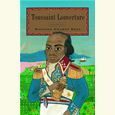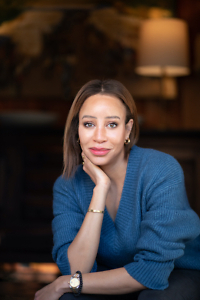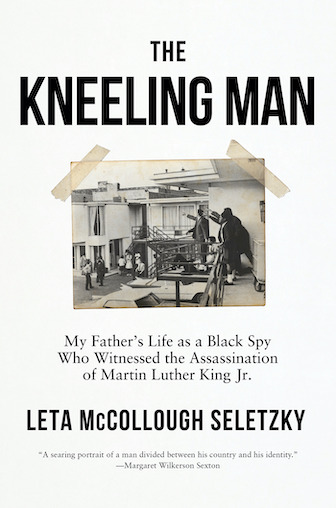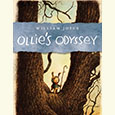With a Big Heart and Big Dreams
Susan Eaddy and Jessica Young compare notes on creating books for very young children
Editor’s note: Susan Eaddy and Jessica Young are longtime friends. Both are children’s authors who work in Nashville, and they belong to the same critique group, helping each other to develop and improve their works-in-progress. Their new books-Eaddy’s Poppy’s Best Babies, and Young’s Play This Book and Pet This Book—share a publication date, and they will launch the new titles together at a kid-friendly event hosted by Parnassus Books on May 20. Prior to the launch party, we asked them to interview each other about their work and their creative habits.
 Jessica Young: Susan, this is your second book about Poppy. Can you tell us a bit about her?
Jessica Young: Susan, this is your second book about Poppy. Can you tell us a bit about her?
Susan Eaddy: Poppy J. Thistleberry is a little bunny with a big heart, big dreams, and lots of creativity and enthusiasm. But as we saw in the first book, Poppy’s Best Paper, she has some work to do on self-control when things don’t go her way.
Young: In this story, Poppy’s family grows, and she has to learn to share her grandma GeeGee with some new siblings. What inspired it?
Eaddy: It started with a friend’s story. She was very close to her only grandchild and was happy to help when the second baby came along. Imagine her shock when the older sibling’s new-baby jealousy was transferred to the formerly beloved Grandmother! While of course, I felt bad for my friend, that story intrigued me with her details of revenge that only a five-year-old could dole out. Meanwhile, my own daughter had recently welcomed twins into the family—thus the inspiration was born.
Your new books, Play This Book and Pet This Book, are different from anything I have seen before from you. How did you get the idea?
Young: My brilliant agent, Kelly Sonnack, knew I was experimenting with prompting readers to interact with books in different ways. She’d been thinking for a long time about how she interacts with books with her own kids and how she hadn’t seen any books encouraging parents to do the same. She mentioned that when she read one classic book to her kids, she always hit the drums and strummed the banjos in the illustrations.
That got us talking about how readers could “play” other instruments. I brainstormed ways kids could manipulate a book—crashing, sliding, and shaking. Later, my wonderful editor, Sarah Shumway, and I brainstormed ideas for a companion book, and the one we liked best was Pet This Book, which prompts readers to care for different animals. (On one spread, the book functions like a puppet, opening and closing a huge mouth illustration as a lizard “eats” from the reader’s hand.)
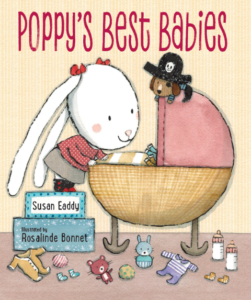 Eaddy: I love that page! Your illustrator Daniel Wiseman did such a great job in pulling that off.
Eaddy: I love that page! Your illustrator Daniel Wiseman did such a great job in pulling that off.
Young: He’s amazing! That illustration has gotten lots of giggles when I’ve read my advanced copies to kids at school visits.
In addition to being an author, you’re also an illustrator who works in clay. How is your creative process different (or not) when you’re writing a book that someone else will illustrate?
Eaddy: It has been quite different for Poppy’s Best Babies. I think you know the story of how hard I tried to illustrate Poppy’s Best Paper in clay. For that I developed illustrations as I went along in writing the first book. Ultimately my clay style wasn’t a good fit for Poppy, and I could not be more delighted with Rosalinde Bonnet’s Poppy art. Knowing that she loved the character and had perfectly portrayed her made my job as writer much easier on this second book. I made a few illustration notes, but that’s it. I knew she would enhance Poppy’s world visually, and I trusted her instincts. Her illustrations make me laugh out loud!
The interactive concept for these books is different from your others. Did you have to pitch them in a different way?
Young: Yes! The first draft of Play This Book was called One Drum. I revised it a bunch and changed the title. Because it was hard to visualize just how the book would look from the illustration notes, my agent suggested I make a book dummy with rough illustrations. With some input from my trusty critique partners (including you!), I cobbled one together and got my kids to make a video demonstrating how it would work.
I love visiting your magical studio. Can you describe it and also talk a bit about your daily routine (if you have one)?
Eaddy: I love it when you visit. I am lucky to have taken over the entire attic of our house. I have different zones for the many aspects of my work. I start out writing or drawing by the window, usually with a cat in my lap. If I’m working on art, when the sketches are done I move to the big computer and play with sizing and composition until I am happy with the drawing (usually with a cat in my lap). Then on to my clay table! It is surrounded by bins of plasticine, organized by color families. All tools and clay are within arm’s reach (no lap cats allowed here—clay and cat hair—ugh).
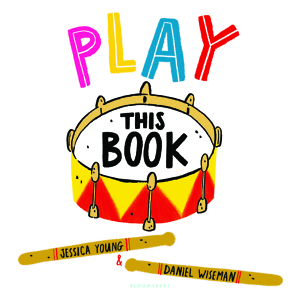 Then on to the second room of the studio where I photograph my art. Cats snoop but know better than to get too close. Back to the computer to prepare files for print. The other part of the studio has a treadmill desk where I tackle my email and/or revise my writing (usually with a cat on the desk—chasing the screen arrow). That desk is surrounded by loads of clay critters tucked away in pizza boxes in the knee wall space.
Then on to the second room of the studio where I photograph my art. Cats snoop but know better than to get too close. Back to the computer to prepare files for print. The other part of the studio has a treadmill desk where I tackle my email and/or revise my writing (usually with a cat on the desk—chasing the screen arrow). That desk is surrounded by loads of clay critters tucked away in pizza boxes in the knee wall space.
And there are lots of books. And toys. And art. And rhinos—200 of my husband’s favorites live with me in the studio.
I know that you have a love of all things musical. Did that help inspire you to create this book?
Young: I’d written a couple of music-themed picture book manuscripts previously, and my agent remembered that when she shared the thoughts that sparked Play This Book. As I experimented with the idea, I wanted to build rhythm, rhyme, and movement into text. Also, I feel like every picture book text is a lot like a song or poem. I have limited time and space to get my ideas out, so I have to choose words carefully. In rhyming books, there’s the additional layer of language to think about, which presents another fun—and sometimes brain-twisting—challenge.
I feel like publishing books is a team sport, and I’m so lucky to have you and my other fantastic critique partners on my team. Getting different perspectives as I work is instrumental in developing my ideas at every stage. Do you want to say something about critiquing?
Eaddy: I would be lost without our critique group. Each of us has a slightly different take on things, and I always know that I will get an honest opinion of what is working and what is not. Usually you guys see something that is not at all on my radar, and that is invaluable. As a matter of fact, this book is dedicated to my critique partners (and the twin granddaughters).
Young: I feel the same way. (And thank you so much for the dedication—it was a sweet surprise the first time I read the book!)
Eaddy: Authors and illustrators are usually kept apart from each other as they work on a book. Did you work at all with the illustrator on the concept and art?
Young: As you say, the author and illustrator are part of a team but typically don’t have much direct contact. I got to see some illustrations during the process, but Daniel and I worked separately. I’m thrilled with the way he introduced the instruments with characters who model how to play them. His bold colors, lively lines, and inviting cast of kids and animals completely transformed the texts. When I saw the art for the first time, it was like getting the best present ever. It’s incredible having someone take your ideas and bring them to life in such a surprising, fun way. He’ll be in town for our joint book launch, so I’m excited to meet him in person and celebrate our new books!
 Susan Eaddy loves to travel and has done school visits all over the world, including Taiwan, Brazil, Switzerland, and Hong Kong. She lives in Nashville.
Susan Eaddy loves to travel and has done school visits all over the world, including Taiwan, Brazil, Switzerland, and Hong Kong. She lives in Nashville.
 Jessica Young grew up in Ontario, Canada. The same things make her happy now as when she was a kid: dancing, painting, music, digging in the dirt, reading, and writing. She lives in Nashville.
Jessica Young grew up in Ontario, Canada. The same things make her happy now as when she was a kid: dancing, painting, music, digging in the dirt, reading, and writing. She lives in Nashville.

